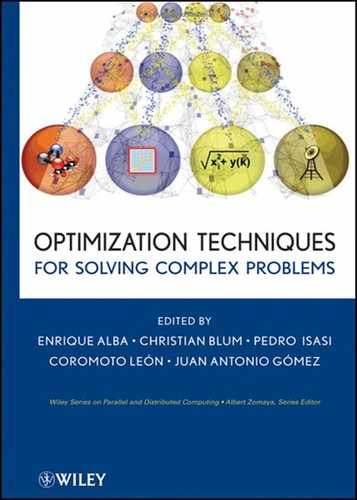 CONTENTS
CONTENTS
PART I METHODOLOGIES FOR COMPLEX PROBLEM SOLVING
1 Generating Automatic Projections by Means of Genetic Programming
C. Estébanez and R. Aler
J. M. Valls, I. M. Galván, and P. Isasi
2.2 Lazy Radial Basis Neural Networks
3 Optimization Using Genetic Algorithms with Micropopulations
Y. Sáez
3.3 Experimental Analysis: The Rastrigin Function
4 Analyzing Parallel Cellular Genetic Algorithms
G. Luque, E. Alba, and B. Dorronsoro
4.2 Cellular Genetic Algorithms
4.4 Brief Survey of Parallel cGAs
5 Evaluating New Advanced Multiobjective Metaheuristics
A. J. Nebro, J. J. Durillo, F. Luna, and E. Alba
5.3 Description of the Metaheuristics
6 Canonical Metaheuristics for Dynamic Optimization Problems
G. Leguizamón, G. Ordóñnez, S. Molina, and E. Alba
6.2 Dynamic Optimization Problems
7 Solving Constrained Optimization Problems with Hybrid Evolutionary Algorithms
C. Cotta and A. J. Fernández
7.2 Strategies for Solving CCOPs with HEAs
8 Optimization of Time Series Using Parallel, Adaptive, and Neural Techniques
J. A. Gómez, M. D. Jaraiz, M. A. Vega, and J. M. Sánchez
8.2 Time Series Identification
9 Using Reconfigurable Computing for the Optimization of Cryptographic Algorithms
J. M. Granado, M. A. Vega, J. M. Sánchez, and J. A. Gómez
9.2 Description of the Cryptographic Algorithms
10 Genetic Algorithms, Parallelism, and Reconfigurable Hardware
J. M. Sánchez, M. Rubio, M. A. Vega, and J. A. Gómez
10.3 FPGA Problem Description and Solution
11 Divide and Conquer: Advanced Techniques
C. León, G. Miranda, and C. Rodríguez
11.2 Algorithm of the Skeleton
12 Tools for Tree Searches: Branch-and-Bound and A* Algorithms
C. León, G. Miranda, and C. Rodríguez
12.3 Algorithmic Skeleton for Tree Searches
12.4 Experimentation Methodology
13 Tools for Tree Searches: Dynamic Programming
C. León, G. Miranda, and C. Rodríguez
13.4 Automata Theory and Dynamic Programming
13.6 Dynamic Programming Heuristics
14 Automatic Search of Behavior Strategies in Auctions
D. Quintana and A. Mochón
14.2 Evolutionary Techniques in Auctions
14.3 Theoretical Framework: The Ausubel Auction
15 Evolving Rules for Local Time Series Prediction
C. Luque, J. M. Valls, and P. Isasi
15.2 Evolutionary Algorithms for Generating Prediction Rules
16 Metaheuristics in Bioinformatics: DNA Sequencing and Reconstruction
C. Cotta, A. J. Fernández, J. E. Gallardo, G. Luque, and E. Alba
16.2 Metaheuristics and Bioinformatics
16.3 DNA Fragment Assembly Problem
16.4 Shortest Common Supersequence Problem
17 Optimal Location of Antennas in Telecommunication Networks
G. Molina, F. Chicano, and E. Alba
17.3 Radio Network Design Problem
18 Optimization of Image-Processing Algorithms Using FPGAs
M. A. Vega, A. Gómez, J. A. Gómez, and J. M. Sánchez
18.3 Main Features of FPGA-Based Image Processing
18.5 Experimental Analysis: Software Versus FPGA
19 Application of Cellular Automata Algorithms to the Parallel Simulation of Laser Dynamics
J. L. Guisado, F. Jiménez-Morales, J. M. Guerra, and F. Fernández
19.6 Parallel Implementation of the Algorithm
20 Dense Stereo Disparity from an Artificial Life Standpoint
G. Olague, F. Fernández, C. B. Pérez, and E. Lutton
20.2 Infection Algorithm with an Evolutionary Approach
21 Exact, Metaheuristic, and Hybrid Approaches to Multidimensional Knapsack Problems
J. E. Gallardo, C. Cotta, and A. J. Fernández
21.2 Multidimensional Knapsack Problem
22 Greedy Seeding and Problem-Specific Operators for GAs Solution of Strip Packing Problems
C. Salto, J. M. Molina, and E. Alba
22.4 Genetic Operators for Solving the 2SPP
22.6 Implementation of the Algorithms
23 Solving the KCT Problem: Large-Scale Neighborhood Search and Solution Merging
C. Blum and M. J. Blesa
23.2 Hybrid Algorithms for the KCT Problem
24 Experimental Study of GA-Based Schedulers in Dynamic Distributed Computing Environments
F. Xhafa and J. Carretero
24.3 Independent Job Scheduling Problem
24.4 Genetic Algorithms for Scheduling in Grid Systems
24.6 Interface for Using a GA-Based Scheduler with the Grid Simulator
25 Remote Optimization Service
J. García-Nieto, F. Chicano, and E. Alba
25.2 Background and State of the Art
25.4 Information Exchange in ROS
26 Remote Services for Advanced Problem Optimization
J. A. Gómez, M. A. Vega, J. M. Sánchez, J. L. Guisado, D. Lombraña, and F. Fernández
